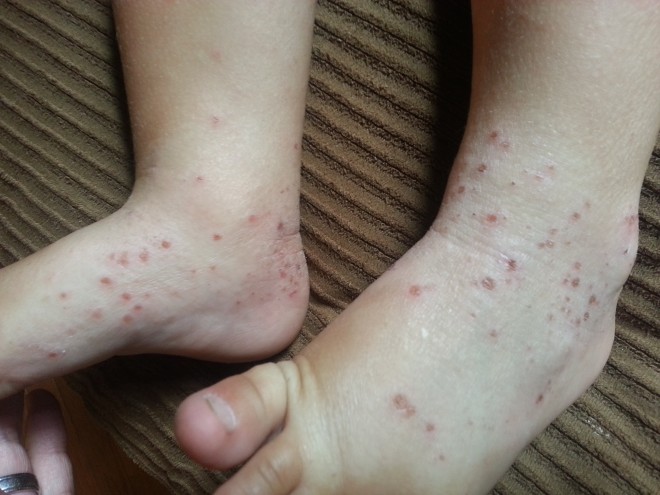Step 1: First of all, make sure it’s really atopic dermatitis!
Atopic dermatitis is a pruritic, immune-mediated skin condition that is common in all age groups, but is particularly common among infants, toddlers and small children. It is commonly called eczema by clinicians and laypersons alike.
There are three different highly pruritic skin conditions that you absolutely need to keep in mind whenever you think about diagnosing atopic dermatitis:
- Scabies is a transmissible skinfold disease that affects multiple household members. Ask if anyone in the household has a similar problem. (If more than one member of the household has a nasty itch, it’s scabies until proven otherwise!). Next, look anywhere you might want to hide if you were a mite. Pay particular attention to interdigital spaces, axillae, and sometimes the groin and intergluteal cleft. Look for papules, excoriations and raised grayish, tortuous lines (burrows). If no other household members are affected and the interdigital spaces and axillae are spared, then the diagnosis of scabies is unlikely. Note that, unlike scabies, atopic dermatitis tends not to hide. It actually favors easy to reach and scratch places like exposed areas of the extremities.
- Dermatitis herpetiformis, as the name suggests, is a clustered blistering disease. Unlike herpes simplex, however, which is very painful and is typically found at points of contact with other people (lips, genitals, and sometimes fingers), dermatitis herpetiformis is an intensely pruritic vesiculopapular lesion found on the knees and elbows (extensor surfaces). It is associated with celiac disease and, unlike atopic dermatitis, it will not respond to topical corticosteroids.
- Contact dermatitis: these patients will have linear streaks (as with poison ivy) or some other geometric or anatomic configuration suggestive of contact with a plant or an article of clothing or jewelry.
Step 2: Achieve and maintain excellent control of the itching with hydroxyzine and of scratching by advising patient or caretaker to closely trim patient’s nails.
This is the most important step. Atopic dermatitis can almost never be brought under control without cessation of scratching. Hydroxyzine tastes horrible, even when it’s “bubble gum” flavored, but it is extremely effective at controlling the itching. So get the unflavored stuff and, for toddlers, mix it with American-style “grape juice” (which is, quite obviously, made of grape juice plus sugar….).
Toddlers should have their nails trimmed several times a week to keep them from tearing up their skin.
Step 3: moisturize heavily.
Grease all dry and scaly areas of the body with coconut oil up to four times daily, and especially after showering or bathing.
Step 4 (concurrent with Step 2): treat the rash with topical corticosteroids.
Start with hydrocortisone 1% and escalate to higher concentration and higher potency steroids. One can also escalate to immunomodulators such as pimecrolimus, but these have been rumored to cause lymphoma. In any event, most of these escalations are actually unnecessary. Treat the itching very aggressively (Step 2) and moisturize heavily (Step 3) and the atopic dermatitis will most likely get better even with a low or medium potency steroid cream.
Step 5 (again, concurrent with Step 2): treat concomitant skin conditions.
Not every skin problem in a patient with atopic dermatitis is atopic dermatitis. Patients with atopic dermatitis have a compromised skin barrier and are colonizes with lots of pathologic microorganisms, particularly Staphylococcus aureus. They are therefore prone to bacterial superinfections such as impetigo and folliculitis. Atopic dermatitis should be pink and itchy. If you are looking at something that is also red and painful (even if it is only painful to look at!), start thinking about antibiotic therapy.


Step 6: avoid quackery, snake oil and pipe dreams.
Stick with what works (Steps 1-5)!


Leave a Reply